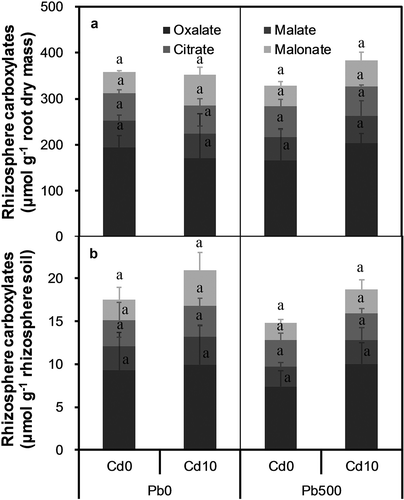Figures & data
Table 1. Physicochemical properties of the loessial soil.
Table 2. Statistical level of significance (P value) of the ANOVAs for dry mass accumulation and partitioning (two-way ANOVA, Cd × Pb), and concentrations of various mineral nutrients in plant parts (three-way ANOVA, Cd × Pb × plant part).
Figure 1. Biomass accumulation and partitioning of alfalfa plants grown on a calcareous soil spiked with different levels of cadmium (Cd) and lead (Pb). (a) Shoot dry mass, (b) Root dry mass, and (c) Root mass ratio. Cd0, Cd10, and Cd20 represent soil Cd level of 0, 10, and 20 mg kg−1, respectively; Pb0, Pb500, and Pb1000 represents soil Pb level of 0, 500, and 1000 mg kg−1, respectively. Data are presented as means ± SE (n = 3). Different lower-case letters above the bars indicate significant (P ≤ 0.05) differences among treatments according to the results of LSD test of two-way (Cd × Pb) ANOVA.
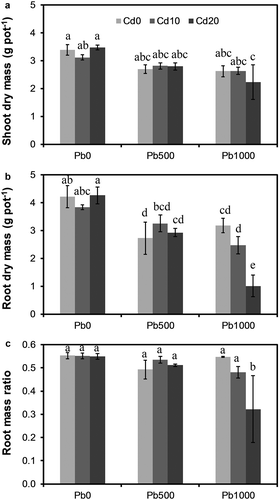
Figure 2. Concentrations of (a) potassium (K), and (b) phosphorus (P) in different parts of alfalfa plants grown on a calcareous soil spiked with different levels of cadmium (Cd) and lead (Pb). Cd0, Cd10, and Cd20 represent soil Cd level of 0, 10, and 20 mg kg−1, respectively; Pb0, Pb500, and Pb1000 represents soil Pb level of 0, 500, and 1000 mg kg−1, respectively. Data are presented as means ± SE (n = 3). Different lower-case letters above the bars indicate significant (P ≤ 0.05) differences among combinations of Cd × Pb × Plant part according to the results of LSD test of three-way ANOVA.
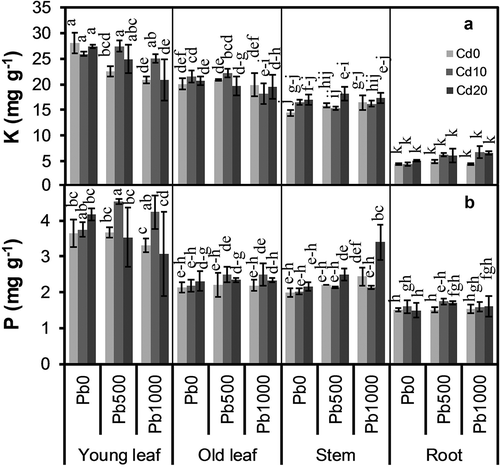
Figure 3. Concentrations of (a) calcium (Ca), (b) magnesium (Mg), and (c) sulfur (S) in different parts of alfalfa plants grown on a calcareous soil spiked with different levels of cadmium (Cd) and lead (Pb). Cd0, Cd10, and Cd20 represent soil Cd level of 0, 10, and 20 mg kg−1, respectively; Pb0, Pb500, and Pb1000 represents soil Pb level of 0, 500, and 1000 mg kg−1, respectively. Data are presented as means ± SE (n = 3). Different lower-case letters above the bars indicate significant (P ≤ 0.05) differences among combinations of Cd × Pb × plant part according to the results of LSD test of three-way ANOVA.
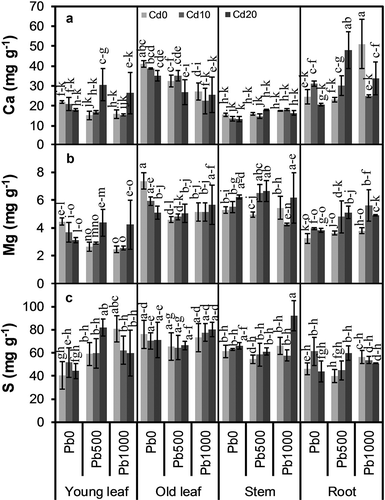
Figure 4. Concentrations of (a) iron (Fe), (b) manganese (Mn), (c) copper (Cu), and (d) zinc (Zn) in different parts of alfalfa plants grown on a calcareous soil spiked with different levels of cadmium (Cd) and lead (Pb). Cd0, Cd10, and Cd20 represent soil Cd level of 0, 10, and 20 mg kg−1, respectively; Pb0, Pb500, and Pb1000 represents soil Pb level of 0, 500, and 1000 mg kg−1, respectively. Data are presented as means ± SE (n = 3). Different lower-case letters above the bars indicate significant (P ≤ 0.05) differences among combinations of Cd × Pb × plant part according to the results of LSD test of three-way ANOVA.
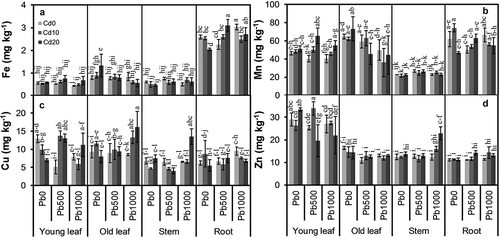
Table 3. pH of the blank pot soil, bulk soil, and rhizosphere extract. Data are presented as means ± SE (n = 3). Different lower-case letters after the SE indicate significant differences among combinations of Cd × Pb × medium type according to the results of three-way ANOVA.
Figure 5. Rhizosphere carboxylates exuded by alfalfa plants grown on a calcareous soil spiked with different levels of cadmium (Cd) and lead (Pb). (a) Amounts of rhizosphere carboxylates calculated on root dry mass basis, and (b) Amounts of rhizosphere carboxylates calculated on rhizosphere soil dry mass basis. Cd0 and Cd10 represent soil Cd level of 0 and 10 mg kg−1, respectively; Pb0 and Pb500 represent soil Pb level of 0 and 500 mg kg−1, respectively. Data are presented as means + SE (n = 3). The same lower-case letters above the bars indicate no significant (P ≤ 0.05) differences among treatments according to the results of LSD test of two-way (Cd × Pb) ANOVA.
